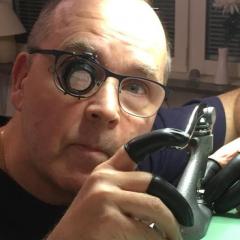What could be the cause of this widely varying rate?
-
Recently Browsing
- No registered users viewing this page.
-
Topics
-
Posts
-
Sorry to say it, but you’re very likely to break or lose something when servicing a wristwatch for the first time — I’ve been there! So, if these watches have any value to you, don’t attempt to service them as a beginner.
-
In writing "shimming the staff" I was alluding to the idea trailed in the above referenced thread of inserting a hair along the staff which, as the discussion there covered, could result in some eccentricity. By making a (more or less) complete cylinder I was hoping to avoid that problem. Don't tell anyone, but needing a very ductile metal to do this by manipulation at such a small scale, I used a piece of an empty Tomato pureé tube! It occurred to me that the material's ductility(?) would also put less stress on the RT in forming a sufficiently tight seal. Anyway, that's how I avoided the temptation to use glue. No doubt your punctuational response to this confession will be "!!!" !
-
Hi All. I would appreciate some advice for a complete newbie on getting into watch servicing - nothing serious, just as a fun project. I've got a thing for hand-wound watches and would like to bring an old watch (or two) back to life, so looking to learn to do a strip-clean-oil-assemble cycle. I've toyed with this idea in the past (years ago) and picked up a couple candidates to learn on, but never found the time for them. One is an old Ingersoll, swiss-made 17 jewels. It seems to wind and tick. Casing, dial, glass are in great shape, so looks like a good candidate to me for the first service. The other is a Benrus DR23. It winds and makes a few reluctant ticks, but then seems to stop. Casing looks like a complete gonner, and the dial is in pretty poor shape too. If the movement is not broken and just needs a service, I wonder if there's any possibility of getting a cheapo Chinese casing & dial to fit this movement in, or is it extremely unlikely to be the right size? For a start, I want to strip & assemble a movement, perhaps a dozen times to build up the basic parts handling skills. I see that online advice is to buy a Chinese-made ST36 for this purpose. Can I just go at the Benrus or Ingersoll instead, or does it make more sense to get a cheap ST for this? Thank you.
-
Hi, I have this vintage Navitimer 806 with a bezel that plays a little bit as shown in this video: https://imgur.com/a/2NjdiF0 How would you fix this? I don't see where a gasket would fit for instance. Also, it seems this issue happens sometimes with older Navitimers. Thanks
-





Recommended Posts
Join the conversation
You can post now and register later. If you have an account, sign in now to post with your account.
Note: Your post will require moderator approval before it will be visible.